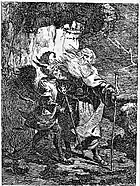Taras Shevchenko
Taras Hryhorovych Shevchenko[note 1] (Ukrainian: Тарас Григорович Шевченко [tɐˈrɑz ɦrɪˈɦɔrowɪtʃ ʃeu̯ˈtʃɛnko], pronounced [tɐˈrɑs] without the middle name; 9 March [O.S. 25 February] 1814 – 10 March [O.S. 26 February] 1861), also known as Kobzar Taras, or simply Kobzar (a kobzar is a bard in Ukrainian culture), was a Ukrainian poet, writer, artist, public and political figure, folklorist and ethnographer. His literary heritage is regarded to be the foundation of modern Ukrainian literature and, to a large extent, the modern Ukrainian language, though this is different from the language of his poems. Due to prosecution of the Ukrainian language, he also wrote selective works in "Great Russian" language (nine novellas, a diary, and an autobiography). Shevchenko is also known for his many masterpieces as a painter and an illustrator.
Taras Shevchenko | |
|---|---|
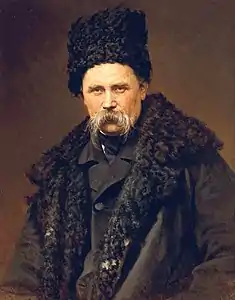 Ivan Kramskoi, Portrait of Taras Shevchenko (1871), Tretyakov Gallery, Moscow | |
| Native name | Тарас Григорович Шевченко |
| Born | 9 March [O.S. 25 February] 1814 Moryntsi, Kiev Governorate, Russian Empire (now Moryntsi, Cherkasy Oblast, Ukraine) |
| Died | 10 March [O.S. 26 February] 1861 (aged 47) Saint Petersburg, Russian Empire |
| Resting place | National Preserve "Taras Hill", Kaniv, Ukraine |
| Pen name | Kobzar Darmohrai, Perebendya[1] |
| Occupation | Poet and artist |
| Language |
|
| Education | Member Academy of Arts (1860) |
| Alma mater | Imperial Academy of Arts (1845) |
| Period | 1840–1861 |
| Notable works | Kobzar |
| Signature | |
 | |
He was a fellow of the Imperial Academy of Arts. Though investigation never determined whether he was a member of the Brotherhood of Saints Cyril and Methodius, Shevchenko was convicted in 1847 of explicitly promoting the independence of Ukraine, writing poems in the Ukrainian language and ridiculing members of the Russian Imperial House. Contrary to the members of the society who did not understand that their activity led to the idea of an independent Ukraine, according to the secret police, he was a champion of independence.
Life
Childhood and youth
.jpg.webp)
Taras Shevchenko was born on 9 March [O.S. 25 February] 1814[note 2] in the village of Moryntsi, Kiev Governorate, Russian Empire.[8] About 20 years following the so called partitions of Poland when the territory of Ukraine where Shevchenko was born had been annexed by the Imperial Russia. He was the third child after his sister Kateryna and brother Mykyta; his younger siblings were a brother, Yosyp, and a sister, Maria, who was born blind.[9] His parents were Kateryna Shevchenko (née Boiko)[9] and Hryhoriy Ivanovych Shevchenko, former subjects of the Polish-Lithuanian Commonwealth became serf peasants who worked the land owned by Vasily Engelhardt, a nephew of the Russian statesman Grigory Potemkin.[10]
In 1816, the family moved to Kyrylivka (modern Shevchenkove), another village owned by Engelhardt, where Taras's father and grandfather had been born. The boy grew up in the village.[9] Once, he went looking for "the pillars that prop up the sky" and got lost. Chumaks who met the boy took him back to the village.[11] From 1822, Shevchenko was sent to a school, where he was taught to read and write. His teacher was the precentor of the village church, whose nickname was "Sovhyr". He was a harsh disciplinarian, who had a tradition of birching the children in his class every Saturday.[12]
On 1 September [O.S. 20 August] 1823 Kateryna Shevchenko died.[12] The widowed Hryhoriy, left to look after six children aged from thirteen to four, had little choice but to remarry. He was married to Oksana Tereshchenko, a widow from Moryntsi, who had three children of her own.[13]
When Hryhoriy Shevchenko became a chumak (travelling merchant), Taras travelled twice with his father and his older brother away from his neighbourhood and, for the first time in his life, on to the open steppe.[14] Hryhoriy died from a chill on 2 April [O.S. 21 March] 1825,[15] and for a period the children's stepmother ruled the family, treating Taras and those siblings still at the family home with great cruelty, until she was expelled by their grandfather, Ivan Shevchenko. For a period Taras lived with his grandfather and his father's brother Pavlo, and was made to work as a swineherd and a groom's assistant.[16] At the age of 12, he left home to work as a student-assistant and a servant for a drunkard named Bohorsky, who had replaced Sovhyr as the village precentor and teacher, and was even more violent than his predecessor. One of Shevenko's duties was to read psalms over the dead. He was treated still more violently by Bohorsky once the boy's stepmother became his mistress.[17]
In February 1827, the 13-year-old Shevchenko escaped from the village and worked for a few days for a deacon in Lysianka, before moving on to Tarasivka. Frustrated in his attempts to become an artist, he returned back to his home village.[18] At around this time, Shevchenko experienced his first love, Oksana Kovalenko, as confirmed by a dedication he later wrote in the poem Mariana, the nun:[19]
It is true, Oksana, alien and black-browed,
That you will not remember the orphan
Who, in a grey jacket, was so happy
To see a wonder - your beauty,
Whom you taught, without talk or words,
How to speak with the eyes, soul and heart,
With whom you smiled, cried, and worried,
To whom you loved to sing a song about Petrus.
You will recall... Oksana, Oksana!
But I still cry today and I still worry,
I pour out my tears for the little Mariana
While I look at you and pray for you.
Remember, Oksana, alien and black-browed,
And deck sister Mariana with flowers.
Sometimes smile happily at Petrus
And, even jokingly, remember what happened.— Taras Shevchenko, Mariana, the nun, Povne I
There is evidence that during this period of his life, Shevchenko was trained by his older brother Mykola to become a wheelwright, and that he also lived with and worked for the family of Hryhoriy Koshytsia, the Kyrylivka priest, who treated Taras well. His duties included driving the priest's son to school, and transporting fruit to markets in Burty and Shpola.[20]
Life as a servant of Pavlo Engelgardt

In 1828, Engelhardt died, and one of his sons, Pavlo Engelgardt, became the Shevchenko family's new landlord. Taras Shevchenko, then aged 14, was trained to become a kitchen servant and the kozachok (court servant) of his new master at the Vilshana estates.[21] There he saw for the first time the luxuries of the Russian nobility.[22]
In 1829, Shevchenko was part of Engelgardt's retinue that travelled to Warsaw, where his regiment was based.[23] By the end of 1829 they had reached Vilno (modern Vilnius). On 18 December [O.S. 6 December] 1829 Engelgardt caught Shevchenko at night painting a portrait of the Cossack general Matvei Platov. He boxed the boy's ears, and ordered him to be whipped.[24] When the party reached Warsaw, Engelgardt arranged for his servant to be apprenticed to a painter-decorator, who, recognising the boy's artistic talents, recommended he receive lessons from a professional artist, Franciszek Ksawery Lampi.[25]
When the November Uprising broke out in 1830, Engelgardt and his regiment were forced to leave Warsaw. His servants, including Shevchenko, were later expelled from the city, forced to leave Polish territory under armed guard, and then make their way to St. Petersburg. Upon arriving there, Shevchenko returned to the life of being a page-boy. His artistic training was delayed for a year,[26] after which he was permitted to study for four years with the painter Vasiliy Shiriayev, a man who proved to be much crueller and controlling than his master in Warsaw..[27] The summer nights were light enough for Shevchenko to visit the city's Summer Garden, where he drew the statues.[25]
In his novel Artist, Shevchenko described that during the pre-academical period he painted such works as Apollo Belvedere, Fraklete, Heraclitus, Architectural barelief, Mask of Fortune He participated in the painting of the Bolshoi Theatre as an apprentice.[28] The composition Alexander of Macedon shows trust towards his doctor Philip was created for a contest of the Imperial Academy of Arts in 1830.[29]
Liberation from serfdom
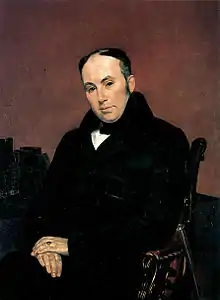
During one of his copying sessions in the city's Summer Gardens, Shevchenko made the acquaintance of a young Ukrainian artist, Ivan Soshenko, a painter and a student of the Imperial Academy of Arts, who came from Bohuslav, close to Shevchenko's home village. Soshenko showed in an interest in Shevchenko's drawings, and recognised the young man's talent.[30][31][32] He was allowed to receive drawing and watercolour painting lessons from Soshenko at the weekend, and when he had spare time during the week. Shevchenko made such progress a portraitist that he was asked by Engelgardt to portray a number of his mistresses.[32]
Soshenko took Shevchenko to Saint Petersburg's art galleries, including the Hermitage.[33] He introduced him to other compatriots, such as the writer and poet Yevhen Hrebinka, the art historian Vasyl Hryhorovych, and the Russian painter Alexey Venetsianov.[8] Through these men in around June 1832, Shevchenko was introduced to the most fashionable painter of the day, the artist Karl Briullov.[31][34] Briullov took an interest in Shevchenko, praising his work and indicating a willingness to take him on as a student. However, as a serf, Shevchenko was ineligible to study under Briullov at the Academy, who requested his freedom from Engelhardt. The request was met with a refusal, which enraged Briullov.[34]
Engelhardt was persuaded to release his servant on condition that a fee of 2500 rubles was paid. To raise this sum, Bryulov painted a portrait of the Russian poet Vasily Zhukovsky as a lottery prize for the imperial family; the winning lottery ticket was drawn by the tsarina.[35][note 3] Engelhardt signed the paperwork that released Shevchenko from serfdom on 5 May [O.S. 22 April] 1838.[31]
Paintings and drawings
After he became a student of the Imperial Academy of Arts, with Bryullov as his mentor, Shevchenko spent most of his time at the academy and in Bryullov's studio.[36][37] Together they attended literary and musical evenings, and visited writers and artists. Shevchenko's social life enriched and expanded his horizons and stimulated his creativity.[36] His friends during this period included Yakov Kuharenko, a writer and officer of the Black Sea Cossack Host, who was to become his friend for life,[38] and the artist Karl Joachim,[36]
From June to November 1838, Shevchenko's examination marks improved enough to allow him to join a compositional drawings class. An early drawing from this class, Cossack Banquet, was completed in December that year. The following month his work was recognised by the Imperial Society for the Encouragement of the Arts, who agrred to pay him a monthly maintenance fee of 30 rubles a month.[39][40]
In April 1839, Shevchenko was awarded a silver medal by the Council of the Academy.[40] He began to master the technique of oil painting, with The Model in the Pose of St. Sebastian being among his earliest attempts. From November, he became seriously ill with typhus.[36] That year, he received another silver medal, this time for his oil painting The Beggar Boy Giving Bread to a Dog.[41] In September 1841, the Academy of Arts awarded Shevchenko his third silver medal, for the painting The Gypsy Fortune Teller. The following May, continual absenteeism from classes forced the Society for the Encouragement of Artists to exclude him from among its free boarders.[36][37] To earn an income he produced book illustrations, such as for Nikolai Nadezhdin's story The Power of Will, Oleksandr Bashutskyi's publication Ours, written off from nature by the Russians, an edition of Wolfgang Franz von Kobell's Galvanography (1843).[36] and a book by Nikolai Polevoy, Russian Generals (1845).[42]
Poetry
_-.jpg.webp)
At the end of 1839, Shevchenko met the sculptor and art teacher Ivan Martos, who showed great interest in his poems. He offered to publish them but, Shevchenko did not immediately agree. Hrebinka took an active and direct part in the publication of Kobzar (1840), it was he who submitted the manuscript to the St. Petersburg censorship committee.[40] Kobzar sold out. It did not openly call for revolutionary actions, but it all contained a protest against social injustice and a desire for a free life.[36]
In March 1840, Hrebinka submitted the manuscript of the almanac Lastivka to the censors, which also included Shevchenko's "Prychynna" and the poems "The wind is raging, the wind is raging!" and "Water flows into the blue sea".[43] In 1841, Shevchenko paid for his epic poem Haidamaky.[36][43] The poem was met with sharp criticism by the literary critic Vissarion Belinsky; in the magazine Otechestvennye Zapiski he criticized Shevchenko's "inclination to romantic pompous ingenuity".[36] Other poems produced by Shevchenko during this period include "Maryana the Nun", "Drowned", and "Blind Man".[36]
While residing in Saint Petersburg, Shevchenko made three trips to Ukraine, in 1843, 1845, and 1846. The difficult conditions Ukrainians had made a profound impact on the poet-painter. Shevchenko visited his siblings, still enserfed, and other relatives. He met with prominent Ukrainian writers and intellectuals Yevhen Hrebinka, Panteleimon Kulish, and Mykhaylo Maksymovych, and was befriended by the princely Repnin family, especially Varvara.
In 1844, distressed by the condition of Ukrainian regions in the Russian Empire, Shevchenko decided to capture some of his homeland's historical ruins and cultural monuments in an album of etchings, which he called Picturesque Ukraine. Only the first six etchings were printed because of the lack of means to continue. An album of watercolors from historical places and pencil drawings was done in 1845.[44]
Plays
Shevchenko 's play Blind Beauty, which was written in c. 1841, has not survived.[36] In 1842, he released a part of the tragedy Mykyta Haidai and, in 1843, he completed the drama Nazar Stodolia.
In the autumn of 1842, Shevchenko planned a sea trip to Sweden and Denmark, but due to illness, he returned home after reaching Revel (modern Tallinn).[40]
First trip to Ukraine
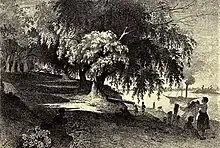
In May 1843, Shevchenko travelled to Ukraine, where he met as many intellectuals, poets, and artists as possible, including the future Brotherhood of Saints Cyril and Methodius member Vasyl Bilozersky.[45][46] During his stay in Kyiv, Shevchenko sketched the city's historical sights and landscapes. After a month he went to Yahotyn, where he befriended the wealthy Repnin family.[46] In October 1843, he wrote his poem "The Dug Grave", after visiting recent excavations of burial mounds that many Ukrainians considered to be symbolic of the heroic past of the Cossacks.[47]
Shevchenko planned to publish an album, Picturesque Ukraine, to consist of his annotated etchings of places and events connected with Ukraine and its past, and use the proceeds to buy his family their freedom.The Society for the Encouragement of Artists gave him 300 rubles to help produce Picturesque Ukraine,[48] but due to his poor planning and lack of business skills, few of the intended etchings with their accompanying text were published, and not enough money was generated from sales to fulfill his dream of buying his siblings' freedom.[49]
Exile
On 22 March 1845, the Council of the Academy of Arts granted Shevchenko the title of a non-classed artist. He again traveled to Ukraine where he met with historian Mykola Kostomarov and other members of the Brotherhood of Saints Cyril and Methodius, a clandestine society also known as Ukrainian-Slavic society and dedicated to the political liberalization of the Empire and its transformation into a federation-like polity of Slavic nations.[50]
In 1844, Shevchenko wrote the poem "Dream" that described the social and national oppression of the Ukrainians by the Russian upper classes.[51] In February, he arrived back in Saint Petersburg from Ukraine.[52] Copies of the poem were confiscated from the society's members and became one of the major issues of the scandal.[53]
Shevchenko was arrested together with the members of the society on 5 April 1847.[54] Tsar Nicholas I read Shevchenko's poem, "Dream". Vissarion Belinsky wrote in his memoirs that, Nicholas I, knowing Ukrainian very well, laughed and chuckled whilst reading the section about himself, but his mood quickly turned to bitter hatred when he read about his wife. Shevchenko had mocked her frumpy appearance and facial tics, which she had developed fearing the Decembrist uprising and its plans to kill her family. After reading this section the Tsar indignantly stated "I suppose he had reasons not to be on terms with me, but what has she done to deserve this?"[55][56]
In the official report of Orlov Shevchenko was accused of composing poetry in "Little-Russian language" (archaic Russian name for Ukrainian language) of outrageous content, instead of being grateful to be redeemed out of serfdom.[50] In the report, Orlov listed the crimes as advocating and inspiring Ukrainian nationalists, alleging enslavement and misfortune of Ukraine, glorifying the Hetman Administration (Cossack Hetmanate) and Cossack liberties and that he "with incredible audacity poured slander and bile on persons of Imperial House".[50]
While under investigation, Shevchenko was imprisoned in Saint Petersburg in casemates of the 3rd Department of Imperial Chancellery on Panteleimonovskaya Street (today Pestelia str., 9). After being convicted, he was exiled as a private to the Russian military garrison in Orenburg[50] at Orsk, near the Ural Mountains. Tsar Nicholas I, personally confirmed his sentence,[57] added to it, "Under the strictest surveillance, without the right to write[50] or paint." He was subsequently sent on a forced march from Saint Petersburg to Orenburg and Orsk.
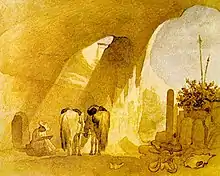
The following year, 1848, he was assigned to undertake the first Russian naval expedition of the Aral Sea on the ship "Konstantin", under the command of Lieutenant Butakov. Although officially a common private, Shevchenko was effectively treated as an equal by the other members of the expedition. He was tasked to sketch various landscapes around the coast of the Aral Sea. After an 18-month voyage (1848–49), Shevchenko returned with his album of drawings and paintings to Orenburg. Most of those drawings were created for a detailed account of the expedition. Nevertheless, he created many unique works of art about the Aral Sea nature and Kazakhstan people at a time when Russian conquest of Central Asia had begun in the middle of the nineteenth century.[58]
He was then sent to one of the worst penal settlements, the remote fortress of Novopetrovsk at Mangyshlak Peninsula, where he spent seven terrible years. In 1851, at the suggestion of fellow serviceman Bronisław Zaleski, lieutenant colonel Mayevsky assigned him to the Mangyshlak (Karatau) geological expedition. In 1857, Shevchenko finally returned from exile after receiving amnesty from a new emperor, though he was not permitted to return to St. Petersburg and was forced to stay in Nizhniy Novgorod.
Shevchenko was eventually allowed to return to St. Petersburg. In the winter of 1858, he saw African-American Shakespearean actor Ira Aldridge perform with his troupe. Using translators, the two became good friends over discussions of art and music and their shared experiences of oppression. Shevchenko drew Aldridge's portrait. Aldridge was later gifted a portrait of Shevchenko by Mikhail Mikeshin.[59][60]
In May 1859, Shevchenko got permission to return to Ukraine. He intended to buy a plot of land close to the village of Pekari. In July, he was again arrested on a charge of blasphemy, but then released and ordered to return to St. Petersburg.
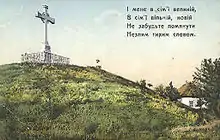
Death
Taras Shevchenko spent the last years of his life working on new poetry, paintings, and engravings, as well as editing his older works. After difficult years in exile, however, his illnesses took their toll upon him. Shevchenko died in Saint Petersburg on 10 March 1861, the day after his 47th birthday.
He was first buried at the Smolensk Cemetery in Saint Petersburg. However, fulfilling Shevchenko's wish, expressed in his poem "Testament" ("Zapovit"), to be buried in Ukraine, his friends arranged the transfer of his remains by train to Moscow and then by horse-drawn wagon to his homeland. Shevchenko was re-buried on 8 May on the Chernecha hora (Monk's Hill; today Taras Hill) near the Dnipro River and Kaniv. A tall mound was erected over his grave, now a memorial part of the Kaniv Museum-Preserve.
Dogged by terrible misfortune in love and life, the poet died seven days before the 1861 emancipation of serfs was announced. His works and life are revered by Ukrainians throughout the world and his impact on Ukrainian literature is immense.
His funeral in Saint Petersburg was attended by such greats of Russian literature as Dostoevsky, Turgenev, Saltykov-Shchedrin and Leskov.[62]
Poetic works
237 poems were written by Shevchenko but only 28 of these were published in the Russian Empire. Six others were published in the Austrian Empire over his lifetime.
Example of poetry: Testament (Zapovit)
Shevchenko's 1845 Testament (Zapovit) has been translated into more than 150 languages and set to music in the 1870s by H. Hladky.
|
Taras Shevchenko, |
Translated by Vera Rich,[63] |
Translated by John Weir,[64] |
Political, philosophical and aesthetic views
Shevchenko is considered to be "the founder of the revolutionary democratic trend in the history of Ukrainian social thought"[65] and a utopian socialist. His political, aesthetic and philosophical worldview was formed under the influence of the ideas of Russian revolutionary democrats such as Herzen, Belinsky, Dobrolyubov and Chernyshevsky; his views reflected the interests of the Ukrainian peasantry of the mid-19th century, the era of the crisis of the feudal-serf system in Imperial Russia.[66]
A serf peasant, ransomed from captivity, Shevchenko was in the words of Russian critic Nikolai Dobrolyubov, "a poet of the people ... He came out of the people, lived with the people, and not only by thought, but by the circumstances of life, was closely and bloodily connected with the people."[67]
Shevchenko was one of the most active participants in a secret political organization in Ukraine, the Brotherhood of Saints Cyril and Methodius and headed the revolutionary nucleus in it. He was associated with a group of Petrashevists (the Petrashevsky Circle was a Russian literary discussion group of progressive-minded intellectuals in St. Petersburg in the 1840s, which also included a young Fyodor Dostoyevsky and radical utopian socialists) who, in their plans for a peasant uprising, hoped to use his revolutionary activities in Ukraine. After his exile, Shevchenko became close to the members of the Sovremennik literary, social and political magazine and its editors, Nikolai Chernyshevsky and Nikolai Dobrolyubov.
While he tirelessly exposed the oppression of the Russian landowners and the Tsar, Shevchenko, as a pan-Slavist, fought for friendship between the Russian and Ukrainian peoples, praised the "glorious of the glorious" Bohdan Khmelnitsky, a 17th-century Ukrainian Cossack leader who had set the stage for the reunification of Ukraine with Russia. Shevchenko advocated the unification of the Slavic peoples on a democratic basis.[68]
Shevchenko did not consider the existing social system to be unshakable, he was convinced that the serf system would be destroyed everywhere due to the development of the steam engine, a technique that would "devour the landlord-inquisitors", and that the most important role in a radical change in social life would be played by the masses. Although he argued that the strength of the spirit cannot manifest itself without matter, he did not call his philosophical position "materialism", understanding by this word the vulgar materialism of contemporary thinkers such as Büchner, Moleschott and Vogt, which he rejected. In his poem, "The Heretic", Shevchenko praised the struggle of Jan Hus (an early 15th-century Bohemian religious reformer) for the interests of ordinary people and the unity of the Slavs.[69]
According to Shevchenko's aesthetic views, which the poet expressed in his Diary,[70] the source of beauty is nature; any attempts to deviate from the eternal beauty of nature make the artist "a moral monster". Shevchenko strove for art that is both national (folkloric) and realistic, and for that he earned the praise of Chernyshevsky[71] and the Russian itinerant painter Ivan Kramskoi, who drew the poet's famous portrait after his death.
In the 1840s and then in the 1850s, in the era of the political struggle within the Empire's intelligentsia between the revolutionary-minded radical wing and the more moderate liberal wing, Shevchenko stood on the side of the Russian revolutionary democrats. His battle poetry, which spread underground, was a sharp weapon in the fight against serfdom. Shevchenko had a great influence on the further development of revolutionary social thought in Ukraine and on Ukrainian culture in general (Ivan Franko, Mykhailo Kotsiubynsky, Lesya Ukrainka, etc.).[72]
Artwork
Of Shevchenko's known paintings and drawings, generally related to Ukraine, Russia, and Kazakhstan, 835 works have survived as original works or as prints or copies made during his lifetime; 270 other works are lost. Shevchenko produced portraits, compositions on mythological, historical, and household themes, architectural drawings, and landscapes, using oils on canvas, watercolour, sepia, ink, and pencil, as well as etchings. Sketches and studies are known, which are of use in understanding Shevchenko's artistic style and methods. Few of his works are signed and an even fewer are dated.
Heritage and legacy
A great number of his pictures, drawings, and etchings preserved to this day testify to his unique artistic talent. He also experimented with photography and it is little known that Shevchenko may be considered to have pioneered the art of etching in the Russian Empire (in 1860 he was awarded the title of Academician in the Imperial Academy of Arts specifically for his achievements in etching.)[73] He inspired some of the protestors during the Euromaidan.[74] The context of his poem "Testament" (Zapovit) was given credit for "resonating" with Ukraine's ongoing struggle during the invasion from Russia in 2022.[75]
Monuments and memorials
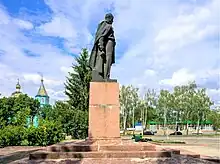
The earliest statues of Shevchenko were created by the authorities in the Soviet Union. The first was unveiled in Romny in October 1918. Statues erected in Moscow in November 1918 and Petrograd in December 1918 perished because they were made of inferior materials, and had to be remade.[76] The monument erected in his name in Saint Petersburg was remade in 2000.[77] There are monuments to Shevchenko throughout Ukraine, such as at his memorials in Kaniv, in the centre of Kyiv, Kharkiv, Lviv, and Luhansk.[77] After Ukraine gained its independence in the wake of the collapse of the Soviet Union, some Ukrainian statues of Lenin were replaced by statues of Shevchenko.[78]
Monuments to Shevchenko have been put up in other countries. These include the granite Taras Shevchenko Memorial in Washington, D.C., a monument in Soyuzivka, New York, statues in the Brazilian cities of Curitiba and Prudentópolis,[77] and in the Croatian capital Zagreb.[79] A bust of Shevchenko was unveiled on 24 September 2010 in the Østre Anlæg Park in Copenhagen.[80]
Other commemorations
In 1957, the Ukrainian-American composer Antin Rudnytsky wrote the cantata Poslaniie, based on Shevchenko's poem of the same name.[81][82]
From 1966 to 1968 artist Hanna Veres made a series of ornamental textiles that she dedicated to Shevchenko. They were used to illustrate the 1971 edition of Kobzar.[83]
See also
- Legacy of Taras Shevchenko
- List of things named after Taras Shevchenko
- From the Ukrainian Wikipedia:
- Reburial of Taras Shevchenko
- Grave of Taras Shevchenko
- Paintings and drawings of Taras Shevchenko
- Bibliography of Taras Shevchenko
- Taras Shevchenko in world literature
Notes
- At the time of birth of Taras Shevchenko, the parish register of the village of Moryntsi was in Russian (the official language of the Russian Empire), and he was recorded as Taras ("To the resident of the village of Morinets Grigori Shevchenko and his wife Katherine was born a son, Taras"[3]). At that time serfs' patronymic names were not identified in documents (for example, see text of a "free-to-go" document from 22 April 1838: "eternally let go my serf person Taras Grigoriev, the son of Shevchenko, whom I inherited after my past parent real privy councilor Vasiliy Vasilievich Engelgardt"). During Shevchenko's lifetime in Ukrainian texts two variants were used: "Taras Grigorievich" (see the letter of Hryhory Kvitka-Osnovyanenko from October 23, 1840: "my lovely lord, Taras Grigorievich")[4] and "Taras Hryhorovych" (the letter of same author from April 29, 1842: "My dear and noble master Taras Hryhorovych").[4] In Russian it is accepted to write «Тарас Григорьевич Шевченко»,[5] in Ukrainian—«Тарас Григорович Шевченко»,[6] in other languages—transliterating from the Ukrainian name, for example "Taras Hryhorovich Shevchenko".
- Note #10 in the parish register of Moryntsi for 1814 (preserved in the Shevchenko National Museum in Kyiv): "In the year one thousand eight hundred fourteen, on the twenty fifth of February, a son, Taras, was born to the resident of the village Morinets Grigori Shevchenko and his wife Catherine..."[7]
- The letters by Zhukovsky asking for payment were illustrated by his own drawings, with captions: This is Mr Shevchenko. He is talking to himself: 'I would like to paint a picture, but my master has ordered me to sweep the floor.' / He is holding his paintbrush in one hand and a broom in the other. He is very upset. / Here Briullov is painting Zhukovsky's portrait. In the distance Shevchenko is sweeping the floor. For the last time. / These are Shevchenko and Zhukovsky. Both are turning somersaults out of joy.'[35]
References
- "До Основ'яненка. Тарас Шевченко. Повне зібрання творів. Том. 1". litopys.org.ua. literary herit/shev113.htm Archived from the original on 7 February 2014. Retrieved 14 February 2014.
{{cite web}}: Check|archive-url=value (help) - "Articles & Essays | Taras Shevchenko | Taras Shevchenko Museum – Toronto". Archived from the original on 4 February 2022. Retrieved 4 February 2022.
- "Документи 1–101. Тарас Шевченко: Документи та матеріали до біографії. 1814–1861". izbornyk.org.ua. Archived from the original on 17 October 2013. Retrieved 14 February 2014.
- Letters to Taras Shevchenko Archived 2013-10-17 at the Wayback Machine. Kyiv: Naukova dumka, 1993.
- Шевченко Тарас Григорьевич in the Great Soviet Encyclopedia, 1969–1978 (in Russian)
- "Vernadsky National Library of Ukraine, Kyiv". Archived from the original on 21 January 2013.
- Shevchenko 1982, volume 3.
- Antokhii, Myroslav; Darewych, Daria; Stech, Marko Robert; Struk, Danylo Husar. "Shevchenko, Taras". Internet Encyclopaedia of Ukraine. Canadian Institute of Ukrainian Studies. Retrieved 13 September 2023.
- Zaĭt︠s︡ev 1988, p. 4.
- Buraček 1939, p. 7.
- Zaĭt︠s︡ev 1988, p. 7.
- Zaĭt︠s︡ev 1988, p. 9.
- Zaĭt︠s︡ev 1988, p. 10.
- Zaĭt︠s︡ev 1988, p. 11.
- Zaĭt︠s︡ev 1988, p. 12.
- Zaĭt︠s︡ev 1988, p. 13.
- Buraček 1939, p. 14.
- Buraček 1939, p. 15.
- Buraček 1939, p. 18.
- Buraček 1939, p. 16.
- Buraček 1939, pp. 16, 19.
- Buraček 1939, p. 20.
- Buraček 1939, p. 21.
- Buraček 1939, p. 22.
- Buraček 1939, p. 24.
- Buraček 1939, pp. 25–27.
- Buraček 1939, pp. 28–29.
- Buraček 1939, p. 13.
- Petrov 1865, p. 251.
- "Soshenko, Ivan". Internet Encyclopaedia of Ukraine. Canadian Institute of Ukrainian Studies. Retrieved 15 September 2023.
- Manning 1960, pp. 1–2.
- Buraček 1939, p. 31.
- Buraček 1939, p. 32.
- Buraček 1939, p. 34.
- Buraček 1939, p. 37.
- Kirilyuk, Shablyuvs'ky & Shubravs'ky 1984, pp. 52–80.
- Zhulynskyi 2015, pp. 270–271.
- "Kukharenko, Yakiv". Internet Encyclopaedia of Ukraine. Canadian Institute of Ukrainian Studies. Retrieved 17 September 2023.
- "Taras Grigorovič Ševčenko (1814-1861)". BnF Data. Bibliothèque nationale de France. Retrieved 17 September 2023.
- Zhur 2003, p. 44–87.
- "Документи 1–101. Тарас Шевченко: Документи та матеріали до біографії. 1814–1861". litopys.org.ua. Archived from the original on 4 August 2020. Retrieved 20 June 2020.
- Polevoy 1845, p. x.
- Kirilyuk 1974.
- "Портал Шевченка". kobzar.ua. Archived from the original on 8 October 2021. Retrieved 8 September 2021.
- Zaĭt︠s︡ev 1988, p. 101.
- Bilyk & Galganova 2014, p. 77.
- Zaĭt︠s︡ev 1988, p. 86.
- Zaĭt︠s︡ev 1988, pp. 105–106.
- Zaĭt︠s︡ev 1988, pp. 107–108.
- Витяг зі справи М. І. Гулака – № 69. Доповідь О. Ф. Орлова Миколі I про діяльність Кирило-Мефодіївського Товариства і пропозиції щодо покарання його членів [Excerpt from the file of M. I. Gulak – No. 69. Report by A. F. Orlov to Nicholas I on the activities of Cyril and Methodius Brotherhood and suggestions for the punishment of its members] (in Russian). Litopys. 26 May 1847. Archived from the original on 19 February 2015. Retrieved 11 July 2014.
- Shevchenko 2003.
- Zaĭt︠s︡ev 1988, p. 104.
- Сон [The Dream] (in Ukrainian). Litopys. Archived from the original on 19 February 2015.
- "Taras Shevchenko". Encyclopedia of World Biography. The Gale Group. 2004. Archived from the original on 12 March 2017. Retrieved 9 March 2017.
- Belinsky, Vissarion (December 1847). Письмо В. Г. Белинского к П. В. Анненкову [Letter from V. G. Belinsky to P. V. Annenkov] (in Russian). Litopys. Archived from the original on 4 November 2016. Retrieved 13 November 2016.
- Karevin, Aleksandr (6 August 2012). Мифы Украины: украинский "соловей" [The myths of Ukraine: the Ukrainian "nightingale"] (in Russian). RusskoeDvizhenie.rf. Archived from the original on 14 November 2016. Retrieved 13 November 2016.
- Peter Kropotkin (1901). "The Present Crisis in Russia". The North American Review. Archived from the original on 7 November 2019. Retrieved 10 November 2019.
- "Арал Тенгизи 1848–1849. Малюнки Тараса Шевченка. Денник Олексія Бутакова. Мандрівки Олексія Макшеєва. pdf" (PDF) (in Ukrainian). Козак Невада, Наутілус. Львів, 2019. Archived (PDF) from the original on 29 August 2021. Retrieved 4 November 2019.
- Corbett, Demetrius M. (1964). "Taras Shevchenko and Ira Aldridge: (The Story of Friendship between the Great Ukrainian Poet and the Great Negro Tragedian)". The Journal of Negro Education. 33 (2): 143–150. doi:10.2307/2294581. ISSN 0022-2984. JSTOR 2294581.
- Kerziouk, Olga (24 October 2014). "Person from a portrait: Ira Frederick Aldridge, the first black Othello". blogs.bl.uk. Retrieved 19 March 2023.
- Андрій Тіток (6 December 2014), Остання путь Кобзаря: як Чернігівщина прощалася з Тарасом Шевченком. Archived 26 September 2015 at the Wayback Machine
- "Taras Grigoryevich Shevchenko".
- Taras Shevchenko. Song Out of Darkness. Selected Poems translated from the Ukrainian by Vera Rich. London: The Mitre Press, 1969
- "Testament. Taras Shevchenko's poems in English". dinternal.com.ua. Archived from the original on 19 March 2015. Retrieved 4 June 2015.
- Rosenthal, Mark & Yudin, Pavel (1954). "Three Ukrainian Enlighteners". A Short Philosophical Dictionary. Translated by P., Anton. Moscow: State Publishing House of the USSR.
- "Шевченко Тарас Григорьевич".
- "Добролюбов Николай Александрович (1860): Кобзарь Тараса Шевченка".
- "Н. Сумцов (1907): Шевченко".
- "Тарас Шевченко — Еретик".
- "Дневник (Шевченко)".
- "Чернышевский Николай Гаврилович (1861): Национальная бестактность".
- "М. Н. Пархоменко (1978): Шевченко Тарас Григорьевич".
- Utevskaya, Paola; Dmitriy Gorbachev (August 1997). 'Он мог бы понять самого Пикассо' [He could have understood Picasso himself]. Zerkalo Nedeli (in Russian). zerkalo-nedeli.com. 30 (147). Archived from the original on 18 January 2005.
- Ayres, Sabra (9 March 2014). "In divided Ukraine, inspiration from a poet of the underdog". The Christian Science Monitor. Archived from the original on 15 March 2014. Retrieved 15 March 2014.
- "Will and Testament by Taras Shevchenko — a Ukrainian poem that resonates today", Financial Times, 10 March 2022, archived from the original on 10 December 2022, retrieved 2 April 2022
- Shurkhalo, Dmytro (14 October 2018). "100 років тому за Гетьманату спорудили перший монументальний пам'ятник Тарасу Шевченку" [100 years ago the first monument to Taras Shevchenko was built for the Hetmanate]. Cуспільство (in Ukrainian). Radio Svoboda. Archived from the original on 23 December 2018. Retrieved 19 September 2023.
- "Monuments to Shevchenko around the world". Taras Shevchenko Museum. Archived from the original on 22 February 2020. Retrieved 30 April 2020.
- Wanner 1998, pp. 186–187.
- Vidmarović, Đuro (23 September 2015). "Otkriena spomen-bista Tarasa Ševčenka" [A monument to Taras Shevchenko unveiled in Zagreb on May 21st] (in Croatian). Croatian Cultural Council. Archived from the original on 23 September 2015.
- "Monuments in Copenhagen". Copenhagen Municipality. 25 October 2022. Retrieved 25 October 2022.
- Wytwycky, Wasyl. "Rudnytsky, Antin". Internet Encyclopaedia of Ukraine. Canadian Institute of Ukrainian Studies. Retrieved 13 September 2023.
- Varshavska 2021.
- Kravets 1968.
Sources
- Bilyk, Olena Ivanovna; Galganova, Oksana Oleksandrivna (2014). Тараса Шевченка І Україн: Рекомендаційний бібліографічний покажчик У двох частинах [Taras Shevchenko and Ukraine: Recommended bibliographic index In two parts] (PDF) (in Ukrainian). Kyiv: National Parliamentary Library of Ukraine.
- Buraček, Mykola (1939). Великий народний художник [Тарас Шевченко] [Great People's Artist [Taras Shevchenko]] (in Ukrainian). Soviet State Publishing House 'Art'.
- Kirilyuk, E. P. (1974). "Шевченко — видавець власних творів" [Shevchenko Is the publisher of his own works] (PDF). Polygraphy and Type (Поліграфія і вид) (in Ukrainian). 10 (10): 10–18.
- Kirilyuk, E. P.; Shablyuvs'ky, E. S.; Shubravs'ky, V. E. (1984) [1964]. "Study at the Academy of Arts: the appearance of Kobzar and Haydamaks (1838-1842)". Т.Г. Шевченко: біографія [T.G. Shevchenko: A Biography] (in Ukrainian). Kyiv: Наукова думка [Scientific Thought]. OCLC 749040916.
- Kravets, Ivan (1968). "Рушники Ганни Василащук Та Ганни Верес" [Towels of Hanna Vasylaschuk and Hannah Veres]. Folk art and ethnography. OUNB named after I. Franka (4): 13–17.
- Manning, Clarence Augustus (1960). Europe's Freedom Fighter: Taras Shevchenko, 1814-1861 - A Documentary Biography of Ukraine's Poet Laureate and National Hero. Washington, D.C.: United States. Congress House.
- Petrov, P. N. (1865). Сборник материалов для истории Имп. С.-Петербургской академии художеств за сто лет ее существования Ч. 2 1811-1843 [Collection of Materials for the History of Imp. St. Petersburg Academy of Arts for a hundred years of its existence] (in Russian). Vol. 2.
- Polevoy, Nikolai Alekseevich (1845). Русские полководцы [Russian Commanders]. Saint Petersburg.
- Shevchenko, Taras (1982). Kyrylyuk, E. P. (ed.). Документи та матеріали до біографії 1814-1861 [Documents and Materials for Biography 1814-1861] (2nd ed.). Kyiv: Kyiv State University.
- Shevchenko, Taras (2003). "Сон [Dream]". In Zhulynskyi, M. G (ed.). Зібрання творів у шести томах [Collection of works in six volumes] (in Ukrainian). Vol. 1. Kyiv: Naukova dumka. OCLC 263307527.
- Varshavska, Alina (2021). "«І МЕРТВИМ, І ЖИВИМ…»: ПРОРОЧІ ІДЕЇ ТАРАСА ШЕВЧЕНКА В КАНТАТІ «ПОСЛАНІЄ» АНТІНА РУДНИЦЬКОГО" [Both Dead and Alive: Prophetic Ideas of Taras Shevchenko in Antin Rudnytsky's 'Poslanie']. Ukrainian Musicology. 47: 150–160. doi:10.31318/0130-5298.2021.47.256746. ISSN 2520-2510. S2CID 249944017.
- Wanner, Catherine (1998). Burden of Dreams: History and Identity in Post-Soviet Ukraine. Penn State Press. ISBN 0271042613.
- Zaĭt︠s︡ev, Pavlo (1988). Taras Shevchenko: A Life. Toronto: Buffalo. ISBN 0802034500.
- Zhulynskyi, M.G., ed. (2015). "Товариство Заохочування Художників" [Society for the Encouragement of Artists]. Shevchenko Encyclopedia (in Ukrainian). Vol. 6. Kyiv: T.G. Shevchenko of the National Academy of Sciences of Ukraine. ISBN 978-966-02-6976-7.
- Zhur, Petro V. (2003). "The Eagle Takes Off". Труди І Дні Кобзаря [The Life and Works of the Kobzar] (in Russian). Kyiv: Library of the Shevchenko Committee. ISBN 5-89114-003-9.
Further reading
- Chaly, Mykhailo Korniyovych (1882). Жизнь и произведения Тараса Шевченко: (свод материалов для его биографии) [Life and Works of Taras Shevchenko: a Collection of Materials for his Biography)] (in Ukrainian). Kyiv: K. N. Milevskoho.
- Koropeckyj, Roman (2014). "The Self-Portraits of Taras Shevchenko: An Attempt at a Typology". Revue des études slaves. 75 (3): 457–474. doi:10.4000/res.474.
- Noack, Christian (2019). "The Riddles of the Shevchenko Cult". In Helgason, Jón Karl; Dović, Marijan (eds.). Great Immortality: Studies on European Cultural Sainthood. Leiden: Brill Publishers. pp. 75–104. ISBN 978-90043-9-513-8.
- Shevchenko, T. Complete collection of works in ten volumes. Kyiv: Academy of Sciences of the Ukrainian SSR, 1951–1964.
- Victor Pogadaev. Taras Shevchenko: Jubli ke-200. – in: Pentas, Jil. 9, Bil. 1 – Mac 2014. Kuala Lumpur: Istana Budaya, 45–49 (in Malay)
- Zhur, Petr (1964). Шевченковский Петербург [Shevchenkovite Petersburg] (in Russian). Lenizdat.
External links
- Works by or about Taras Shevchenko at Internet Archive
- Works by Taras Shevchenko at LibriVox (public domain audiobooks)

- Information about the National Museum of Taras Shevchenko in Kyiv, from Museum Portal
- Taras Shevchenko Museum, Toronto, Canada (official website)
- Information about facsimile editions of works by Shevchenko designed by Volodymyr Yurchyshyn from the British Library
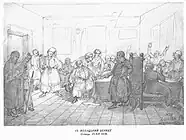

_%D0%A6%D0%B8%D0%B3%D0%B0%D0%BD%D0%BA%D0%B0-%D0%B2%D0%BE%D1%80%D0%BE%D0%B6%D0%BA%D0%B0.jpg.webp)
